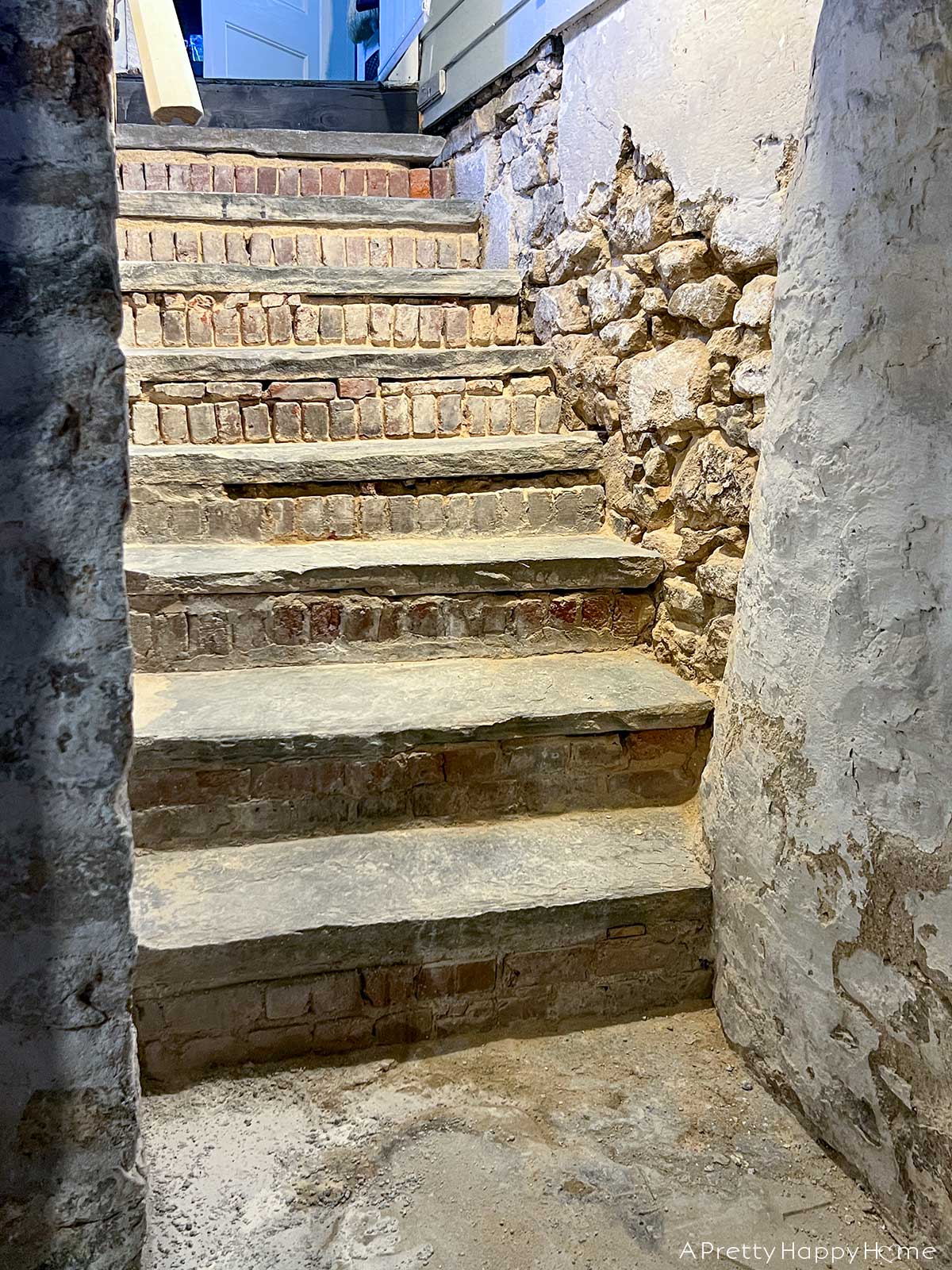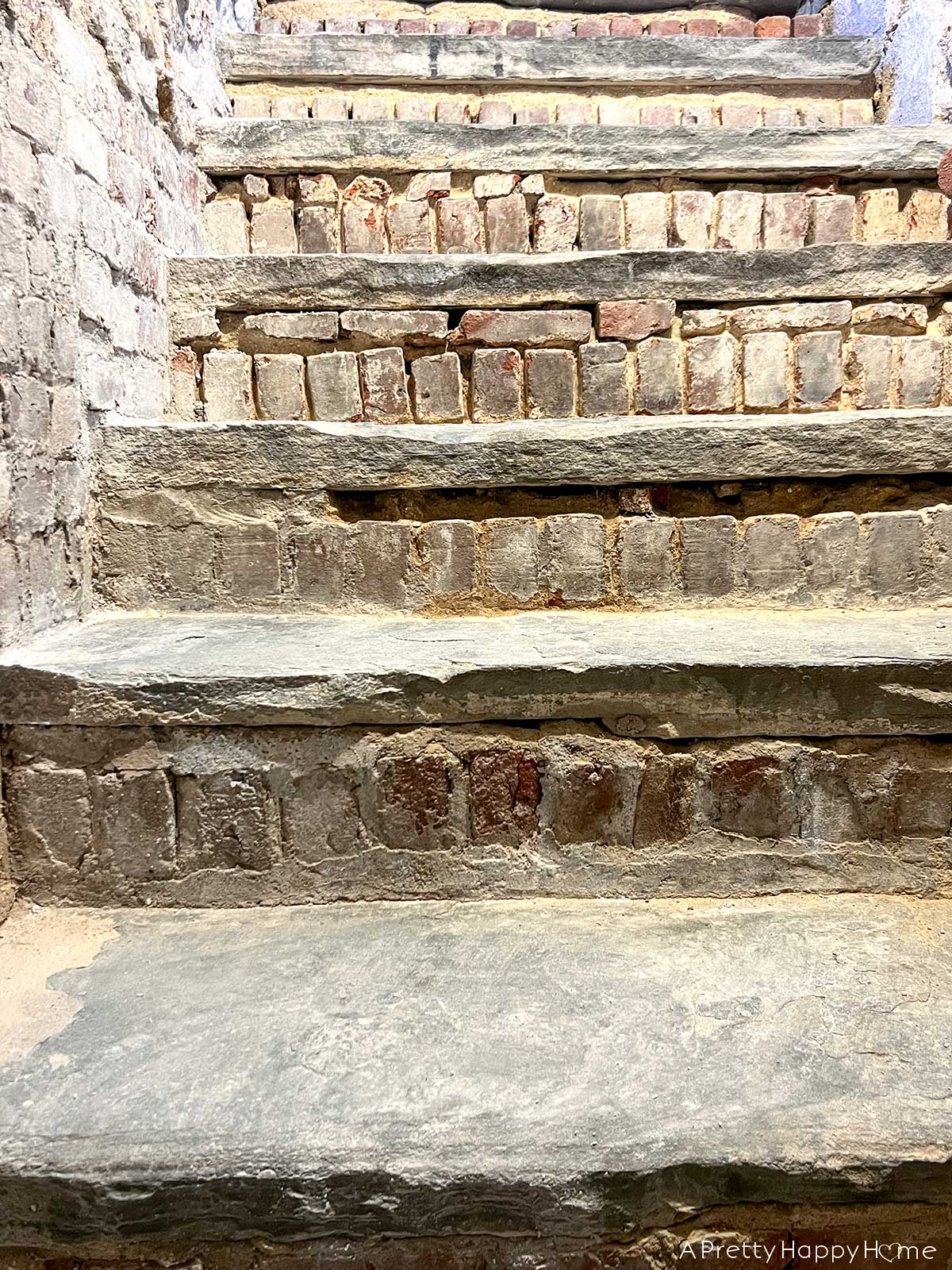
Foot Wear On Our Stone Steps and A Basement Mystery
I noticed an interesting thing while we’ve been repointing the basement. There is foot traffic wear on our stone steps.
If you look closely, you can see the slight dip on the left side of the stairs closest to the handrail, especially on the fourth and fifth stairs down from the top.
Fascinating, right?
How old do stone steps have to be and how much foot traffic do stone steps have to receive before the treads start wearing down?
I’m not sure.
I went spelunking on the internet to try and find the answer to this question. There might be a mathematical way to solve this question but we are missing variables.
If you buy stone today for this purpose, there is a way to tell how well your stone steps should perform when it comes to foot traffic.
The American Society for Testing and Materials (ASTM) has a standard test method for abrasion resistance of stone subjected to foot traffic. Between you and me, since I was not going to conduct a standardized test for this blog post, I did not want to pay $63 for the PDF to find out how this is done.
I did learn from the Coldspring site, a natural stone fabricator, that this test that I did not want to pay to learn more about results in an Abrasive Hardness value, or Ha. The higher the value, the more abrasive resistant the stone will be to foot traffic wear. Exterior pavers and high-volume areas like a lobby need to have a minimum Ha of 12. For residential applications, the minimum Ha is 6.
At the risk of stating the obvious, it’s safe to say we have a residential application since this is a house.
However, our stone steps look more like steps designed for an exterior, instead of a highly refined interior application.
Therefore, by my rough calculations, these stone steps are probably, most likely, fairly, depending on the situation, pretty abrasive resistant.
PHEW! Glad we cleared that up.
It’s also safe to say these stone steps have been here for a long time.
How long?
This is where the mystery comes in. Our house dates back to the 1780s, so the stone steps can’t be older than that, assuming they were cut new specifically for this house.
The stone steps connect the basement to the kitchen addition of the house.
We have been operating under the assumption that the kitchen is roughly 100 to 120 years old and that this entrance to the basement was created when this addition was added.
Our assumption about the age of the kitchen addition and the connecting basement stairs was formed based on when indoor plumbing was available in the United States and that our roofing company thought that, underneath all the roofing layers, it looked like a 100 – 120-year-old roof.
Supporting that theory is the fact that two other entrances to the basement have been abandoned over time. One of the entrances has similar stone steps. The other is just a door to nowhere. If you were able to open that door up, it would be dirt and concrete on the other side.
But now that we’ve had time to study how the basement is constructed, how the kitchen addition is constructed, and how the stairs fit into everything, we just don’t know.
Maybe the stairs were there with cellar doors at the top (also called Bilco, bulkhead, or hatchway doors) and then the kitchen was added around the stairs. Maybe when the kitchen was added they did indeed bust through the foundation to add the stairs to the basement. Maybe the kitchen is older than we think. Maybe there’s another option we haven’t thought of yet.
It’s a mystery.
Until I can find documentation to support any of these theories, it will remain a mystery.
What will also remain are these gorgeous stone steps, which we are restoring to their former glory. We are in the process of removing the old lime mortar around the bricks and stones and replacing it with new lime mortar, which should last for a century or so.
I may not know how old these stone steps are or how many people have walked on them, but I do know they are showing signs of wear. That added character and slight imperfection make them even more gorgeous to me.
I have this romantic notion that if two people walk the same path or in this case, stairs, they share a connection. I like the idea of being connected to the people who lived here before me. It makes me feel like one small part of a much larger story.
Do you have these romantic notions too? How about house mysteries? Do you have any of those? I’d love to know. You can always comment on this blog post, email us here, or reach out via Instagram or Facebook.
P.S. Most old homes I’ve been in have wood steps into the basement. I love it so much that we have stone steps. It gives added character to the space and this is one thing in this old house that does not and will not need replacing anytime soon. Thank goodness.
Thanks for being here today! I love tackling mysteries and sharing ideas with you. Here are some other blog posts you might enjoy.
Why We Decided To Repoint Our Stone Walls Ourselves
How To Remove Plexiglas Film That Is Stuck On The Plexiglass









2 Comments
Sherin
‘Spelunking,’ my new favourite word!
annisa
It’s a good one, isn’t it?